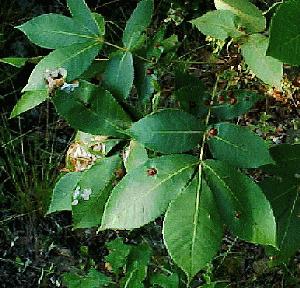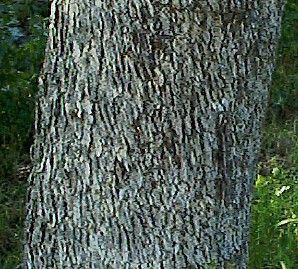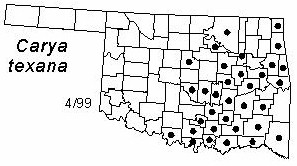

Tree to 10 m (30 ft) tall and 30 cm (12 in) diameter, with irregular spreading crown. Bark blackish or dark gray, becoming thick, rough, and deeply furrowed on older trunks and branches. Twigs slender, brown, rusty-hairy when young. The single terminal bud is small, egg-shaped, with rusty-hairy overlapping scales. Leaves alternate, pinnately compound, 15-30 cm (6-12 in) long, rachis rusty-hairy when young. Leaflets 5 or usually 7, lanceolate, 5-15 cm (2-6 in) long, acuminate, finely serrate, rusty-hairy when young, becoming shiny dark green above, pale green below. Flowers catkins appearing in the early spring. Fruits rounded, 3-4 cm (1.2-1.6 in) long, with a thin husk. Seeds thick-shelled, edible.
Distribution: Native to southeastern U. S., but absent from coastal areas and lowlands.
Habitat: Eastern Cross Timbers and the drier portions of the Oak-Hickory and Oak-Pine forest types.
NWI status: none
Comment: The nuts of all the hickories are important food for wildlife, especially squirrels. The seeds of black hickory are thick-shelled but edible. Carya is the ancient Greek name for walnut; texana refers to Texas, where the species was first described.
Distribution in Oklahoma: 
BACK
NEXT
RETURN TO INDEX
Last update: 9/8/99
 Go to Oklahoma Biological Survey Home Page
Go to Oklahoma Biological Survey Home Page
 Disclaimer
Disclaimer